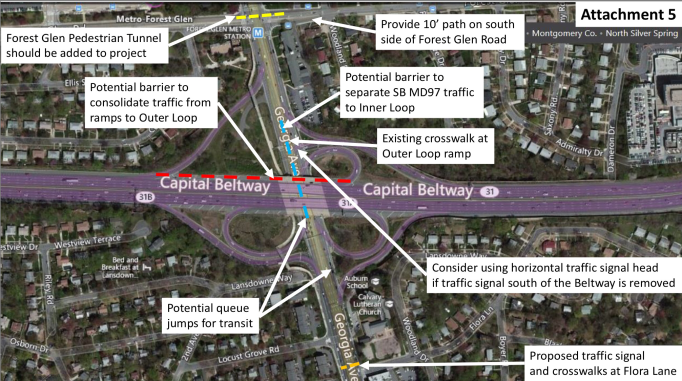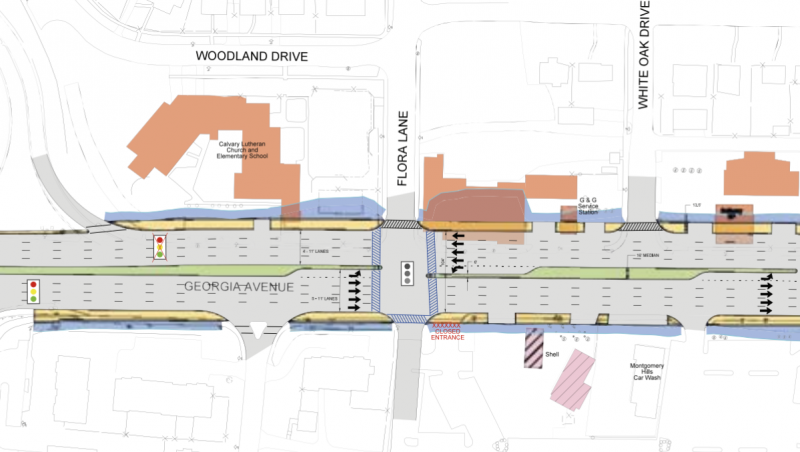Here’s how Montgomery County could prioritize pedestrian safety in White Flint, Forest Glen, and beyond

Image by Jesper2cv licensed under Creative Commons.
Recently three people were struck by drivers and killed in Montgomery County, illustrating the need for better pedestrian and biker safety. In our first post, we wondered what would happen if the $140 million dollars committed to certain car-centric projects like Montrose Parkway East Parkway were used for other purposes, such as increasing pedestrian safety in White Flint.
In neighboring Forest Glen, pedestrian safety has also been an issue for many years, and yet there has been minimal investment in making the area more walkable. This is especially surprising given the number of public facilities and amenities close to transit along the busy corridor.
Forest Glen is a nice place to live — but pedestrian safety is a big issue
Forest Glen, a census designated area with approximately 6,582 residents over a 1.4 square mile area that is divided by Georgia Avenue on the east and west sides, boasts a Metro stop, a 443-bed regional hospital (Holy Cross), Army base (Walter Reed Forest Glen Annex), and national museum — all within a quarter mile of the Capital Beltway. It is also a short bike ride from this area to several popular parks along Sligo Creek and Rock Creek.
There are also several popular, high-use parks at nearby Evans Parkway which were recently renovated by the county. Many large and active church buildings line Georgia Avenue and are used by multiple, diverse congregations throughout the week. A new health center was also just opened by the county on nearby Dennis Avenue. Furthermore, all of these amenities are actively visited by pedestrians, bike riders, and mass transit users.
The neighborhood is also currently the focus of redevelopment efforts by WMATA, namely the possibility of converting an eight-acre surface parking lot into a mixed-use development with an emphasis on supporting Holy Cross Hospital. For more than two decades, the community has been advocating for constructing a second Metro entrance on the east side of Georgia Avenue so residents would not have to cross an eight-lane highway just to get to the station.
It is particularly dangerous to cross this state road on foot. The lack of a second entrance has also prevented any transit-orientated development (often called TOD) to occur since the construction and opening of the Forest Glen station in 1990.
Proposed Forest Glen East entrance. Image by MCDOT.
In addition, those who live on the other side of the beltway in Forest Glen have to deal with a Georgia Avenue corridor that hasn’t been upgraded since it was first widened several decades ago. Although SHA is currently working on a re-design, many of these projects have been seemingly stuck in funding queues at both the county and state levels for several years, with little or no progress in sight.
A section of Georgia Ave proposed improvements. Image by MD-SHA.
What could the $140 million price tag for the Montrose Parkway East pay for?
Here are just a few suggestions.
1) A new White Flint Metro entrance
2) An Eastern Forest Glen entrance
3) A whole host of pedestrian improvements in White Flint
4) Georgia Avenue redesign
5) More bikeshare programs
Image by Rich Renomeron licensed under Creative Commons.
Looking to 2018 and beyond
With the sector plan consolidation of Forest Glen and Montgomery Hills, the county has an opportunity to use funds in a way that could provide safety measures to over 12,000 residents on a day-to-day basis. This could not only spark smart growth on almost 15 acres of available land but could also make Forest Glen and Montgomery Hills a safer and more walkable community.
In addition, after millions of dollars in investment in White Flint, MoCo also has an opportunity to increase pedestrian safety in a way that enhances the new urban nature of White Flint while protecting its sensitive green spaces. In the support of this endeavor, community advocates have created a petition urging the Montgomery County leadership to take the steps needed to make these pedestrian improvements a reality.
Just like consumers advocated for car safety many years ago, pedestrians and community members alike must stand together to advocate for a better and safer walkable Montgomery County.
Read Part 1 — Montgomery County must improve pedestrian safety in White Flint, advocates say. This post was first published on Finding Forest Glen.




